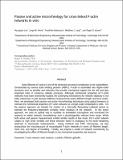Passive and active microrheology for cross-linked F-actin networks in vitro
Author(s)
Nakamura, Fumihiko; Lee, Hyungsuk; Ferrer, Jorge M; Lang, Matthew J; Kamm, Roger Dale
Download2009_Lee_et_al_Rev_2_AfterCorrection_Final.pdf (966.3Kb)
PUBLISHER_CC
Publisher with Creative Commons License
Creative Commons Attribution
Terms of use
Metadata
Show full item recordAbstract
Actin filament (F-actin) is one of the dominant structural constituents in the cytoskeleton. Orchestrated by various actin-binding proteins (ABPs), F-actin is assembled into higher-order structures such as bundles and networks that provide mechanical support for the cell and play important roles in numerous cellular processes. Although mechanical properties of F-actin networks have been extensively studied, the underlying mechanisms for network elasticity are not fully understood, in part because different measurements probe different length and force scales. Here, we developed both passive and active microrheology techniques using optical tweezers to estimate the mechanical properties of F-actin networks at a length scale comparable to cells. For the passive approach we tracked the motion of a thermally fluctuating colloidal sphere to estimate the frequency-dependent complex shear modulus of the network. In the active approach, we used an optical trap to oscillate an embedded microsphere and monitored the response in order to obtain network viscoelasticity over a physiologically relevant force range. While both active and passive measurements exhibit similar results at low strain, the F-actin network subject to high strain exhibits non-linear behavior which is analogous to the strain-hardening observed in macroscale measurements. Using confocal and total internal reflection fluorescent microscopy, we also characterize the microstructure of reconstituted F-actin networks in terms of filament length, mesh size and degree of bundling. Finally, we propose a model of network connectivity by investigating the effect of filament length on the mechanical properties and structure.
Date issued
2009-10Department
Massachusetts Institute of Technology. Department of Biological Engineering; Massachusetts Institute of Technology. Department of Mechanical EngineeringJournal
Acta Biomaterialia
Publisher
Elsevier
Citation
Lee, Hyungsuk, Jorge M. Ferrer, Fumihiko Nakamura, Matthew J. Lang, and Roger D. Kamm. “Passive and Active Microrheology for Cross-Linked F-Actin Networks in Vitro.” Acta Biomaterialia 6, no. 4 (April 2010): 1207-1218.
Version: Author's final manuscript
ISSN
17427061